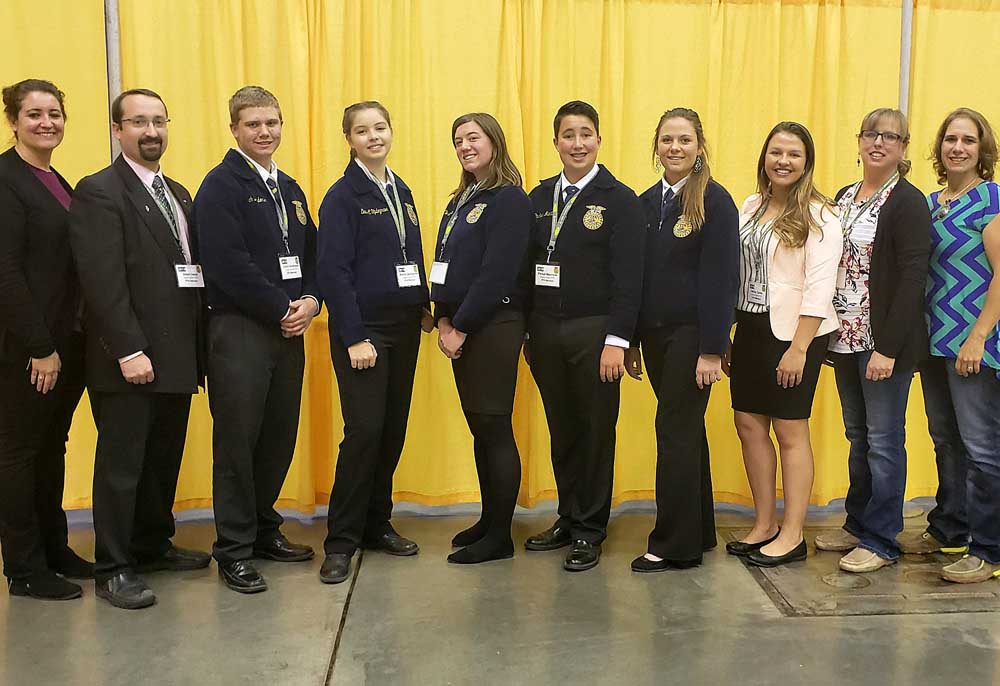AG DAY: FFA program prepares students for future
Published 4:15 pm Tuesday, March 19, 2019

- Attending the National FFA Convention & Expo are, from left, Grant Union Career Coordinator Kristi Moore, FFA adviser Adam Ineck, FFA members Cinch Anderson, Emilie Updegrave, Ellie Justice, Parker Manitsas, Kori Jo Girvin, Hailey Carter and chaperones Jennifer Carter and Cori Anderson.
With experts predicting more than 9 billion hungry mouths on the planet by 2050, the need for skilled and knowledgeable agricultural workers armed with the latest ideas and technologies is more important than ever before.
The world will need workers trained in precision agriculture, “ranching and farming by the inch,” Adam Ineck told the Eagle.
Raised on a row-crop farm in southwest Idaho that produced corn, alfalfa and commercial beef cattle, Ineck is the ag ed teacher at Grant Union Junior-Senior High School.
He has a bachelor of science in agriculture education from the University of Idaho and is pursuing a master’s in agriculture education through Oregon State University. He’s been an ag ed teacher and FFA advisor for the past 15 years.
“I often tell people I’m a farmer by birth, teacher by trade and an agriculturist by choice,” he said.
High-tech farming
Evolving agricultural technologies include drones, thermal imagery, precision planting and robotics. But a recent survey by the Land O’Lakes Foundation found that only 3 percent of surveyed college graduates said they had considered a career in agriculture.
According to Purdue University, the 34,500 new graduates with expertise in food, agriculture, renewable natural resources and environmental issues will fill just 61 percent of the 57,900 job openings expected annually. Ineck hopes to help address that need by exposing high school students to the diversity of the “natural resource, food and fiber system.”
“It’s more than cows, plows and sows,” he said.
His goal is to prepare students for their next step, whether it’s a two- or four-year college or heading off straight to work. His classes and the FFA program are laying the groundwork for the problem-solvers of the future.
Ag workers will need to understand how to use pedometers and GPS to track individual cows on a cellphone app, and what types of crops and soils work best with precision drip irrigation, Ineck said. This drive for efficiency generates numerous opportunities for students who go into agriculture, he said.
Agricultural productivity has dramatically increased in just the past half century. The average amount of milk produced per cow increased from 5,314 pounds per year in 1950 to 18,201, the average yield of corn rose from 39 bushels per acre to 153 and each farmer produced on average 12 times as much farm output per hour in 2000 as a farmer in 1950.
In 1870, about half the people in the U.S. were employed in agriculture. Today it’s less than 2 percent. Americans today are two or three generations removed from a life on the family farm, Ineck said.
“I’m trying to reconnect them to their sources,” he said.
The FFA program became a national organization in 1928 when it was known as Future Farmers of America. The name was changed to the National FFA Organization in 1988 and is now commonly referred to as FFA, with more than 669,000 members in more than 8,600 chapters guided by more than 13,000 agriculture educators.
The FFA experience
Ellie Justice, a junior at Grant Union, lives on a small farm outside Prairie City that raises nursery plants. Her family hearkens back to homesteading days on her father’s side and a grandfather on her mother’s side who came to Grant County and got into logging.
Justice said she’s been involved in 4-H since elementary school and has raised sheep, chickens, beef cows and crickets. The latter were part of an FFA “supervised agricultural experience” program, she said.
FFA had much to do with her development, Justice said, from helping the community and moving her career forward to providing opportunities for research, entrepreneurship and job shadowing. She said she was inspired by Ineck and wants to pursue a degree in education and then return to small-town life in Eastern Oregon.
Parker Manitsas, a sophomore at Grant Union, lives in John Day where he raises show hogs under the FFA program. His brother Matt is the ag project leader for the city’s future commercial greenhouse program. Parker is interested in pursuing a career in education.
FFA is a platform that builds confidence in students who are growing up and learning who they are, Manitsas said. He’ll put that experience to work at the FFA State Convention in Redmond on March 22-25 where he’ll present a speech on bio-security that won at district and sectional meets.
Manitsas said he spent a lot of time researching the topic and rehearsing for the speech. After talking about good practices that limit traffic to livestock to reduce transmission of diseases, he will be peppered with questions from the audience for five minutes and needs to come out sounding like an expert, he said.
The career path
Like Manitsas, Kori Jo Girvin lives in John Day, not on a farm or ranch, but she spent time on family-owned ranches every other year in Idaho. She started raising 4-H pigs in fifth grade, but through FFA she’s been involved in soil judging, livestock judging and public speaking.
Girvin will compete in the parliamentary procedure event at the state convention. As a committee chairperson, she must ensure that the issues debated by a committee are conducted according to Roberts Rules of Order.
A senior at Grant Union, Girvin plans to join the Air Force after graduating and pursue a college degree through the military. She credits FFA with providing her with many of the skills she’ll need later in life.
Cinch Anderson, a junior at Grant Union, has lived on a cattle ranch near Izee since he was 2. The family leases the ranch and pastures 200-250 cattle on a 50,000-acre allotment in the Malheur National Forest. There’s some flood irrigation, but the Andersons purchase hay, he said.
Like all farm kids, Anderson has daily chores like feeding grain to show cattle and bulls, but his duties picked up recently when his parents went on vacation. Seasonal work includes delivering hay to livestock in winter and moving cattle around on Forest Service land to comply with regulations.
The Andersons do all their work on horseback — not ATVs. It’s a 45-minute drive to school, longer in deep winter snow, and he knows his experience is very different than other students at Grant Union. It’s harder, but it’s a way of life that he grew up to appreciate. He said he feels lucky to be able to work with his parents and two younger sisters.
Anderson is the local FFA chapter vice president and plans to run for state FFA office next year. He completed eight days of auctioneer training in Iowa last June and wants to pursue that career path after attending Treasure Valley Community College. He also plans to continue working on ranches and eventually return home to Izee.






